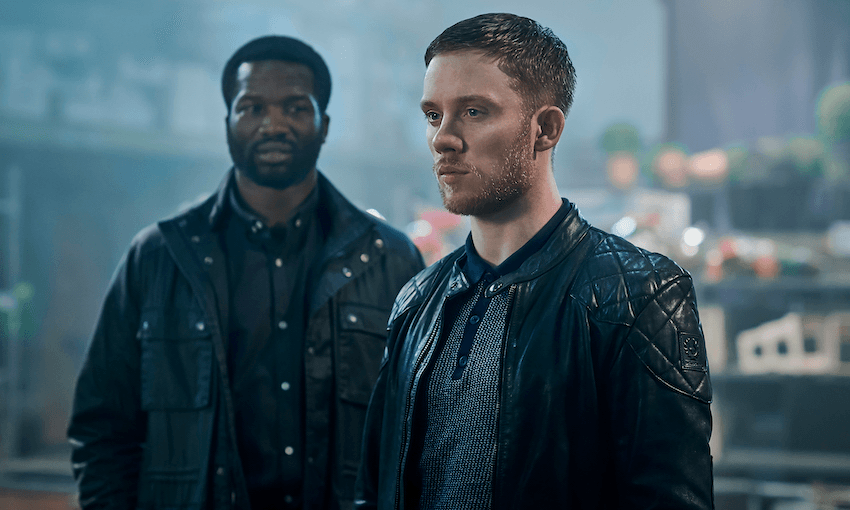You probably shouldn’t expect any happy endings from buzzed-about new Neon show Gangs of London, but maybe that’s not such a bad thing.
The Hero’s Journey, a 17-stage literary structure popularised by the 20th century work of literature professor Joseph Campbell but present through centuries of storytelling, lays out for creators and consumers a well-trodden path: the departure, the initiation, and the return. These stages can sometimes be easy to spot in a big heroic tale – think Arya Stark’s long journey away from and return to Winterfell in Game of Thrones – but the framework can also be a lot of fun in how it shows us how self-important a hero can become over the course of a story.
It’s not just the good guys, though. In Breaking Bad, Walter White’s departure is in the form of beginning to lead his double life as a meth manufacturer. His initiation occurs when he begins to dabble in the criminal world, which leads to his eventual kingpin status as Heisenberg. It’s the return that gets muddied in antihero stories – how can a bad guy truly become the master of two worlds, or attain the freedom to live? Both are hallmarks of Campbell’s hero’s journey, but both can be harder to detect in a story without a moral centre.
Directed by modern action demigod Gareth Edwards (The Raid), Gangs of London is the latest in a legacy of slick blockbuster dramas to invite the audience into a galaxy of complex allegiances with complex people. What makes this one especially complicated, though, is that all of its main players are objectively nasty pieces of knitting – rather than the conflict between good and evil, it’s the tension of bad versus bad that keeps us on our toes here. Is Elliot (Sope Dirisu), the heavy who is climbing the ranks of the Wallace corporation, more innocent than anyone else? What about Sean Wallace (Joe Cole), the son of the slain gang boss, driven by love and revenge?
Gangs of London is driven by this central relationship. Sean is obviously the worse guy, but Elliot has the higher body count. What can an audience do with that, ethically speaking? One of the great excitements of Gangs of London is the almost-but-not-quite over-the-top video game violence. We all become utilitarian philosophers when we watch someone with motives for the greater good ploughing through the streets of London, taking out everyone in his path. What are these individual lives worth in contrast to an anti-corruption mission?
The fun of the antihero story is that when there just simply isn’t anyone who is purely good, you have to shift your allegiances as new evidence arises – as Elliot hardens and Sean softens, our sense of right and wrong blurs and we can sink into the high stakes, never quite sure who to trust, driven only by emotion and instinct.
We can also transfer some of that moral burden onto the smaller players, hoping to find someone we can form an ethical bond to. This is something which iconic antihero dramas like The Wire and The Sopranos managed to pull off, and Gangs of London has a large enough ensemble of supporting players to do the same thing – its underworld clans are easily identifiable and discernible by their looks, their uniforms and their languages. The gangsters are slick, well-groomed and elegantly besuited. The consequences of drug crime, the embodied epidemic of opiate addiction, is by contrast shown in the grotty flats and grottier clothes of those affected.
One of the brilliant things about Gangs Of London is the way that it plays with our sympathies, and manipulates our affections. This is particularly successful when played out among the gangs lower on the food chain than the Wallaces. The animosity between Asif, the Pakistani kingpin, and Lale, the Kurdish militant turned heroin boss, is made complicated by the sympathies on either side. Asif is a full-blown monster, but his son is someone you could really get behind. Lale is bloodthirsty, but everything she does she does for her people. Meanwhile the Wallaces are ivory tower gangsters, living a life of luxury, trained to kill by a psychopathic patriarch.
Fragile masculinity is abundant in hero stories and antihero stories alike, as characters like Walter White, Tony Soprano and Jimmy McNulty are almost defined by their sulkiness, their inability to deal with their feelings and fears in healthy ways. Similar dynamics play out in Gangs of London – Sean Wallace is an emotional powder keg waiting to explode, and Elliot can’t stay on mission because his feelings get in the way.
The antihero’s return is almost always categorised by death, because we can’t bear to let a bad guy win. Without spoiling the exhilarating first season’s thrilling conclusion, it’s safe to say that death abounds, yet resurrection is always a possibility. And that’s the most wonderfully frightening thought of all – what if the bad guy didn’t die? If you aren’t already on the Gangs of London trip, now might be a good time to hop on board.

